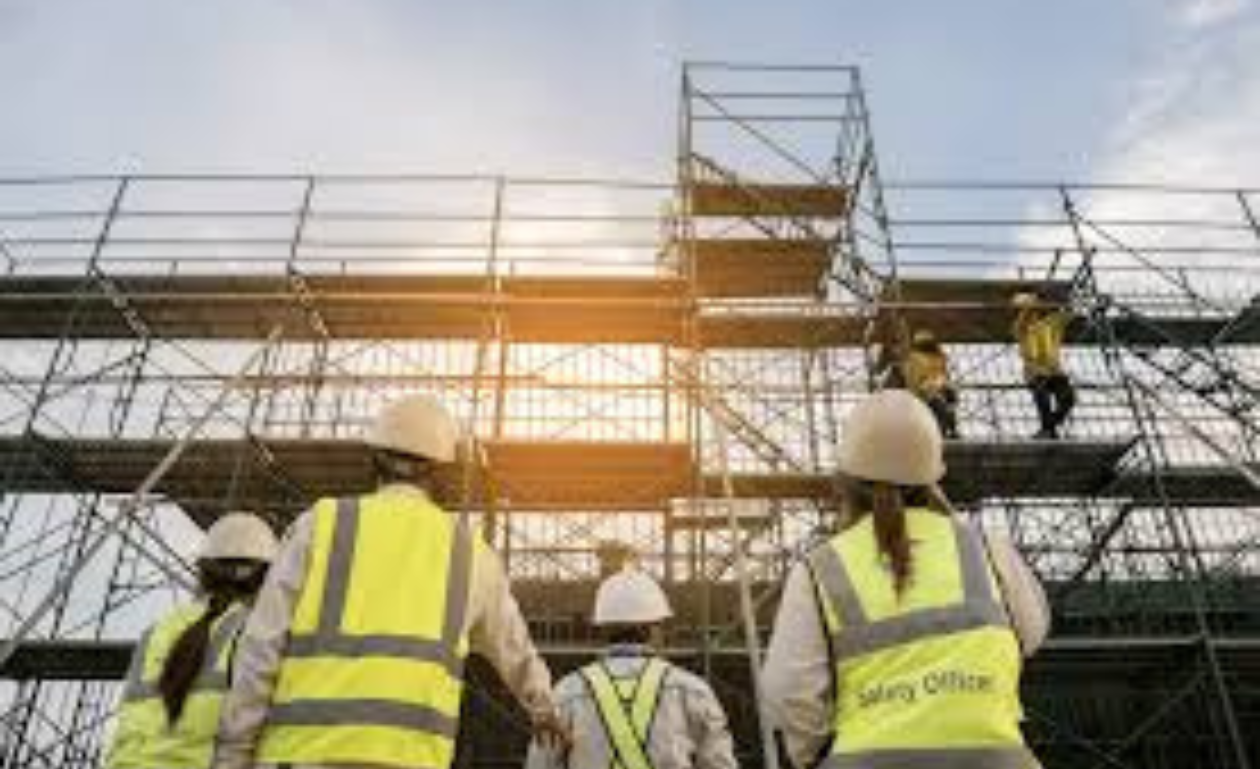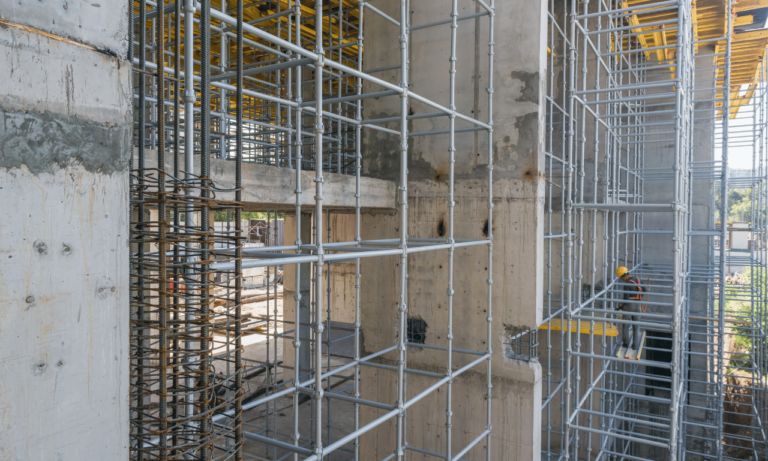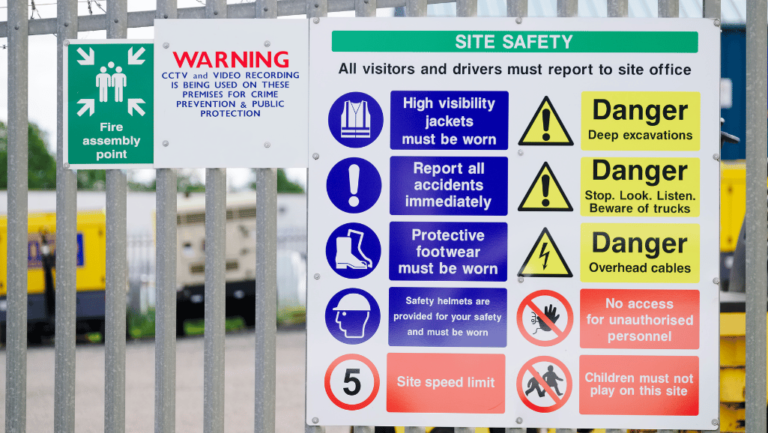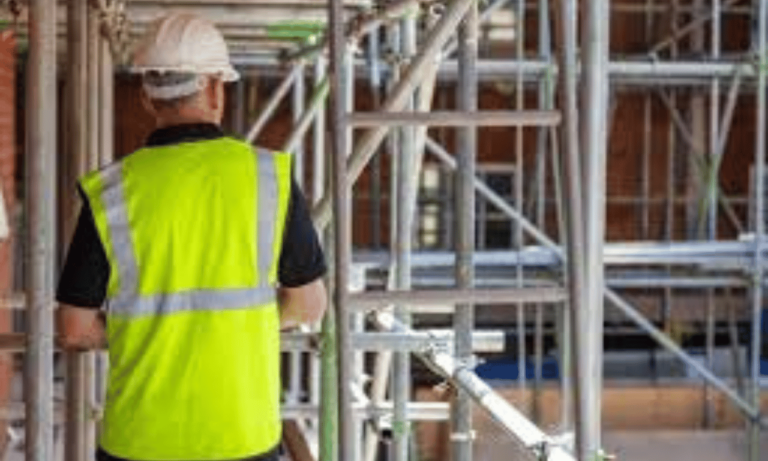Phone:
(+65)8319-0742
Welcome to our article on Scaffold Safety Orientation, where we will discuss the crucial tips and guidelines to ensure construction site safety and compliance with OSHA regulations for scaffolding. Construction sites are inherently hazardous, making it essential for workers to receive proper training and follow the necessary safety protocols when working on scaffolds. By prioritizing scaffold safety orientation, construction professionals can mitigate risks and create a secure working environment.
OSHA regulations for scaffolding are in place to protect the welfare of workers and prevent accidents. Understanding and adhering to these regulations is crucial for the construction industry. This article will provide valuable insights into the specific regulations and guidelines established by OSHA, highlighting the importance of compliance to uphold construction site safety.
Identifying scaffold hazards and taking preventative measures is vital to safeguarding workers. This article will delve into the common hazards associated with scaffolding and provide practical tips on how to prevent them. We will emphasize the significance of proper workplace safety training and the implementation of scaffolding safety rules to ensure a secure working environment.
Regular scaffold inspections are crucial to identify any potential issues and ensure compliance with safety regulations. Our article will present a comprehensive scaffold inspection checklist that covers essential areas to examine. By following this checklist, construction professionals can maintain construction site safety and adhere to OSHA regulations.
Falls remain one of the most significant hazards for scaffold workers, making fall protection guidelines paramount. This section will highlight the necessary safety equipment, such as harnesses and guardrails, to prevent falls. We will also stress the importance of proper training and adherence to scaffolding safety rules in keeping construction workers safe from fall-related accidents.
Training and effective communication play a vital role in fostering scaffold safety. We will discuss the significance of comprehensive workplace safety training for all workers, ensuring they are well-versed in Scaffold Safety Orientation. Additionally, we will emphasize the importance of establishing clear communication channels to disseminate safety protocols effectively.
In conclusion, Scaffold Safety Orientation is critical to maintain construction site safety and comply with OSHA regulations. By following the essential tips and guidelines provided in this article, construction professionals can create a safe working environment and protect their workers from hazards. Prioritizing scaffold safety orientation ensures that everyone involved in construction projects can work confidently and securely.
Key Takeaways:
- Proper scaffold safety orientation is essential for construction site safety and compliance with OSHA regulations.
- Adhering to OSHA regulations and guidelines for scaffolding prevents accidents and promotes a safe working environment.
- Identifying scaffold hazards and implementing preventative measures are crucial to mitigate risks.
- Regular scaffold inspections using a checklist are necessary to ensure compliance and maintain safety.
- Fall protection guidelines, including safety equipment and adherence to safety rules, prevent falls for scaffold workers.
Understanding Scaffold Safety Regulations
When it comes to construction site safety, adhering to scaffold safety regulations is of utmost importance. These regulations, set by the Occupational Safety and Health Administration (OSHA), provide specific guidelines that aim to prevent accidents and ensure a safe working environment on scaffolding structures.
By understanding and following these regulations, construction professionals can protect workers from potential hazards and mitigate the risks associated with scaffolding operations. Let’s explore some key aspects of scaffold safety regulations:
OSHA Regulations for Scaffolding
OSHA has developed strict regulations for scaffolding to ensure the safety of workers in the construction industry. These regulations cover various aspects, including scaffold design, construction, inspection, and use.
- Proper scaffold construction: OSHA guidelines specify the requirements for scaffold materials, dimensions, and strength. Construction professionals must comply with these guidelines to ensure the structural integrity of scaffolds and prevent collapse.
- Secure access and egress: Scaffold safety regulations emphasize the importance of providing safe and secure access points for workers. This includes the installation of guardrails, stable stairways, and ladders with proper safety features.
- Load capacity and stability: OSHA regulations define the maximum load capacity of scaffolds based on their design and construction. It is crucial to adhere to these weight limits and ensure the stability of scaffolds to prevent accidents.
- Fall protection measures: Scaffold safety regulations require the use of fall protection systems, such as harnesses, guardrails, and safety nets, to prevent falls from elevated platforms.
- Regular inspections: OSHA mandates regular inspections of scaffolds by competent personnel to identify any potential hazards or defects. These inspections help ensure that scaffolds are safe for use and comply with safety regulations.
By understanding and implementing these regulations, construction professionals can create a safe working environment that prioritizes the well-being of workers and minimizes the risk of accidents.
Training and Compliance
Ensuring compliance with scaffold safety regulations requires comprehensive training and ongoing education for all workers involved in scaffold operations. Construction companies should provide Scaffold Safety Orientation programs that cover the following:
- Proper assembly and disassembly of scaffolds
- Safe use of scaffold components and equipment
- Recognition and prevention of scaffold hazards
- Emergency procedures and evacuation plans
- Compliance with OSHA regulations and industry best practices
Regular refresher courses should be conducted to reinforce these training programs and keep workers updated on any changes in regulations or best practices.
Benefits of Adhering to Scaffold Safety Regulations
Adhering to scaffold safety regulations brings numerous benefits to construction sites, including:
- Reduced risk of accidents and injuries
- Improved workplace productivity and efficiency
- Enhanced reputation for safety among clients and stakeholders
- Compliance with legal requirements, avoiding penalties and legal liabilities
By prioritizing scaffold safety and adhering to OSHA regulations, construction professionals demonstrate their commitment to creating a safe working environment for all workers.
Identifying Scaffold Hazards and Prevention
When working on scaffolding, it is crucial to prioritize safety and take proactive measures to prevent hazards. Construction sites can be risky environments, but by implementing the right scaffolding safety rules and providing proper workplace safety training, these risks can be significantly reduced. In this section, we will explore the various hazards associated with scaffolding and discuss effective strategies for prevention.
The Importance of Workplace Safety Training
Workplace safety training plays a critical role in protecting workers and minimizing accidents. By ensuring that all employees receive comprehensive training specific to scaffolding hazards, they will be equipped with the knowledge and skills necessary to work safely and identify potential risks. Some key areas that workplace safety training should cover include:
- Proper assembly and disassembly of scaffolding structures
- Safe work practices while working at heights
- Understanding weight limits and load capacities
- Recognizing and responding to potential hazards
- Correct use of personal protective equipment (PPE)
By investing in workplace safety training, construction companies can create a culture of safety and empower their workers to take an active role in preventing accidents and injuries.
Implementing Scaffolding Safety Rules
Having clear and well-defined scaffolding safety rules is essential for maintaining a safe work environment. These rules should be based on industry best practices and comply with relevant regulations, such as OSHA standards. Some important scaffolding safety rules to consider include:
- Regular inspections of scaffolding structures
- Securing scaffolding to prevent movement or collapse
- Ensuring the proper installation and use of guardrails
- Using stable and level surfaces for scaffold placement
- Prohibiting unauthorized access to scaffolding
- Implementing a clear communication system for scaffold workers
By enforcing these scaffolding safety rules consistently, construction companies can minimize the potential for accidents and create a safer working environment for their employees.
Visualizing the importance of scaffolding safety and hazard prevention, here is a comprehensive table highlighting common scaffold hazards and recommended prevention measures:
| Hazard | Prevention |
|---|---|
| Lack of fall protection | Ensure the use of proper fall protection equipment, such as harnesses, guardrails, and safety nets. |
| Overloading of scaffolding | Adhere to weight limits and load capacities. Avoid placing excessive weight on the scaffolding. |
| Unsafe access and egress | Provide secure access points, such as staircases or ramps, and ensure proper installation and maintenance. |
| Unstable scaffolding | Inspect scaffolding regularly for stability and address any issues promptly. Secure the scaffolding to prevent movement or collapse. |
| Insufficient training | Provide comprehensive workplace safety training specific to scaffolding hazards. Ensure workers are knowledgeable and skilled in safe practices. |
By being aware of these hazards and taking the necessary prevention measures, construction professionals can create a safer work environment for themselves and their colleagues, reducing the risk of accidents and injuries.
Scaffold Inspection Checklist
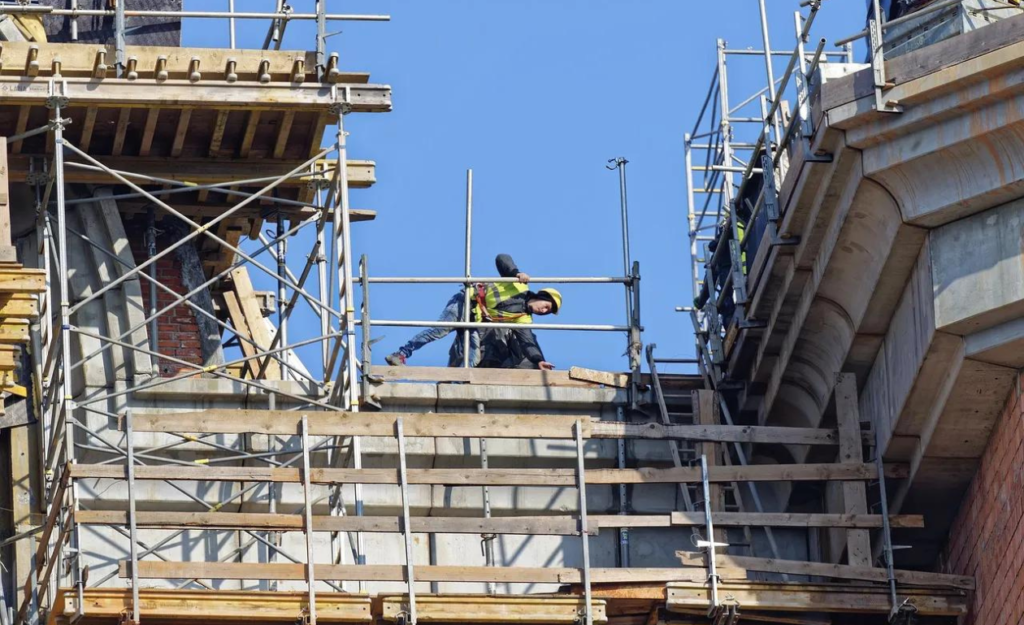
Ensuring construction site safety and compliance with OSHA regulations scaffolding is of utmost importance in any project. A crucial element in maintaining a safe working environment is conducting thorough scaffold inspections. By following a comprehensive scaffold inspection checklist, construction professionals can identify potential hazards, mitigate risks, and protect the well-being of workers.
The scaffold inspection checklist should cover the key areas to examine in a scaffold structure. These include:
- Scaffold Stability: Check for any signs of instability, such as uneven or soft ground, loose or damaged foundation components, or inadequate bracing.
- Guardrails and Toeboards: Inspect the presence and integrity of guardrails and toeboards to prevent falls from heights.
- Access Points: Ensure that safe and secure access points, such as ladders or stairways, are provided for scaffold entry and exit.
- Platform and Working Area: Inspect the scaffold platform for any defects, including missing planks, improper spacing, or debris that may pose a tripping hazard.
- Fall Protection: Verify the availability and proper use of personal fall arrest systems, such as harnesses, lifelines, and anchor points.
- Overhead Hazards: Assess the scaffold’s proximity to overhead hazards, such as power lines or moving equipment, and ensure adequate clearance to avoid accidental contact.
- Load Capacity: Confirm that the scaffold structure can support the intended load capacity, factoring in both the workers and equipment to be used on the scaffolding.
- Storage and Transport: Determine if materials, tools, and equipment are stored and transported properly, avoiding clutter and ensuring stability during movement.
A thorough scaffold inspection checklist serves as a valuable tool for site supervisors, safety officers, and workers alike. By diligently following the checklist and promptly addressing any identified issues, construction professionals prioritize construction site safety and comply with OSHA regulations.
Take a look at the following table for a visual representation of the scaffold inspection checklist:
| Inspection Area | Checkpoints |
|---|---|
| Scaffold Stability | â
Check for ground stability â Inspect foundation components â Ensure adequate bracing |
| Guardrails and Toeboards | â Verify presence and integrity |
| Access Points | â Provide safe and secure access |
| Platform and Working Area | â Inspect for defects and debris |
| Fall Protection | â Confirm availability and proper use |
| Overhead Hazards | â Assess proximity and clearance |
| Load Capacity | â Ensure scaffold can support intended load |
| Storage and Transport | â Store and transport materials safely |
By conducting regular scaffold inspections and addressing any identified issues promptly, construction professionals create a safer working environment, reducing the risk of accidents and prioritizing the well-being of all workers involved.
Continue reading our next section where we will discuss fall protection guidelines specifically tailored to scaffold workers.
Fall Protection Guidelines for Scaffold Workers
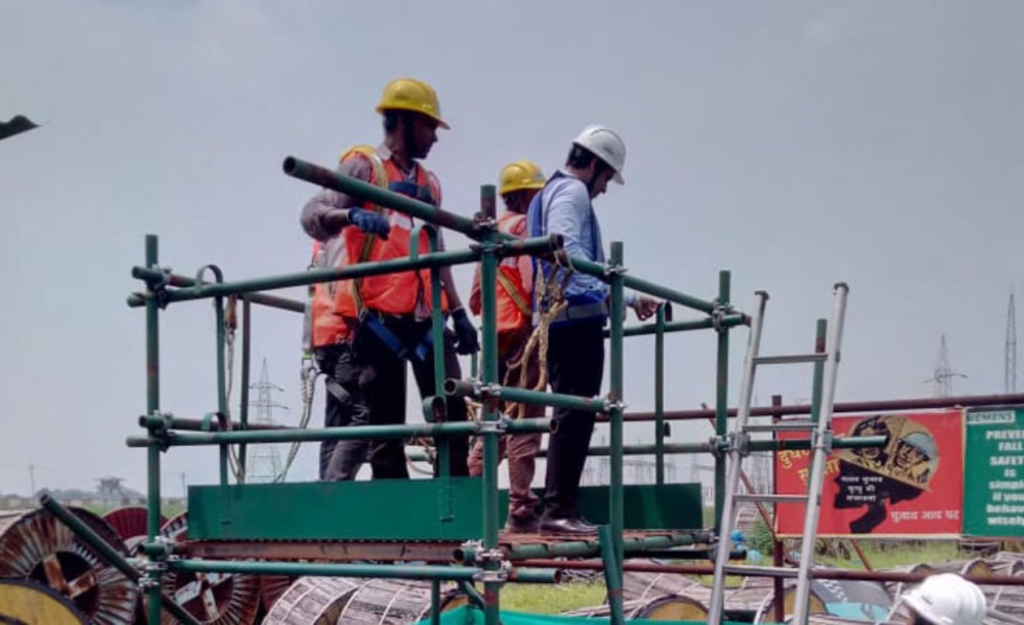
When working on scaffolds, ensuring fall protection is of utmost importance to maintain construction site safety and prevent accidents. Scaffold workers face specific risks due to the nature of their work, making it essential to follow fall protection guidelines and scaffolding safety rules. This section will provide valuable information on how scaffold workers can protect themselves from falls and create a secure working environment.
One crucial aspect of fall protection is the proper use of safety equipment. Scaffold workers should always wear **harnesses** that are securely attached to a reliable anchor point. This ensures that in the event of a fall, the worker will be prevented from hitting the ground and potentially suffering severe injuries.
In addition to harnesses, guardrails should be installed around all open sides and ends of the scaffold platform. These guardrails act as a protective barrier and minimize the risk of workers accidentally falling off the scaffold. (Insert relevant information from the OSHA regulations here, highlighting the importance of guardrails in scaffold safety.)
Moreover, it is crucial for scaffold workers to receive proper training on fall protection and scaffold safety. Training should cover topics such as the correct use of safety equipment, recognizing potential fall hazards, and understanding the importance of adhering to scaffolding safety rules. By equipping workers with the necessary knowledge and skills, they can actively contribute to a safer working environment.
Key Fall Protection Guidelines for Scaffold Workers:
- Always wear a properly fitted harness and connect it to a reliable anchor point.
- Inspect the harness for any signs of wear or damage before each use.
- Ensure the scaffold platform has guardrails installed on all open sides and ends.
- Regularly inspect guardrails for stability and secure attachment.
- Do not remove or alter guardrails without proper authorization.
- Follow scaffold safety rules and guidelines provided by employers or site supervisors.
- Participate in regular safety training sessions to stay up-to-date with fall protection practices.
- Report any fall hazards or safety concerns to the relevant authority immediately.
By following these fall protection guidelines and prioritizing scaffold safety, workers can significantly minimize the risk of falls and ensure a secure working environment. Remember, prevention is key to safeguarding lives and promoting construction site safety.
Training and Communication for Scaffold Safety

Effective workplace safety training is crucial for promoting scaffold safety and ensuring the well-being of workers. By providing comprehensive training programs, construction companies can equip their employees with the knowledge and skills necessary to navigate potential hazards and adhere to construction safety guidelines.
One of the key components of scaffold safety training is the Scaffold Safety Orientation. This orientation program is designed to familiarize workers with the specific safety protocols and procedures related to scaffolding on construction sites. It covers essential topics such as proper scaffold assembly, inspection, and fall protection guidelines.
During the Scaffold Safety Orientation, workers learn to identify potential scaffold hazards and the appropriate preventive measures. They gain a comprehensive understanding of OSHA regulations pertaining to scaffolding and how to comply with them. With the emphasis on workplace safety training, individuals are empowered to take responsibility for their own safety and the safety of their colleagues.
In addition to training, effective communication plays a significant role in ensuring scaffold safety. Clear and open communication channels need to be established on construction sites, allowing workers to report potential hazards, seek clarification on safety procedures, and share important information regarding scaffold safety.
Regular safety meetings and toolbox talks provide opportunities for supervisors and workers to discuss safety concerns, reinforce training concepts, and address any questions or uncertainties. These discussions foster a culture of safety awareness and encourage everyone to actively participate in maintaining a safe working environment.
To further enhance communication, utilizing visual aids such as safety signs and posters can effectively reinforce important safety messages. These visual cues serve as constant reminders of the construction safety guidelines and help to ensure that awareness of the Scaffold Safety Orientation remains high throughout the worksite.
Training and Communication Best Practices:
- Implement comprehensive scaffold safety training programs that cover OSHA regulations and construction safety guidelines.
- Include a specific Scaffold Safety Orientation as part of the training program.
- Establish clear communication channels for reporting hazards and seeking safety-related information.
- Conduct regular safety meetings and toolbox talks to discuss safety concerns and reinforce training concepts.
- Utilize visual aids such as safety signs and posters to enhance communication and promote safety awareness.
Conclusion
Throughout this article, we have explored the importance of Scaffold Safety Orientation in maintaining construction site safety and complying with OSHA regulations for scaffolding. By implementing the essential tips and guidelines discussed, construction professionals can ensure a safe working environment on scaffold structures.
Understanding Scaffold Safety Regulations is crucial in preventing accidents and creating a secure workplace. Adhering to the specific guidelines set by OSHA ensures that scaffolding is erected, used, and dismantled correctly, minimizing risks for workers.
Identifying Scaffold Hazards and Prevention is another critical aspect. By conducting proper workplace safety training and implementing scaffolding safety rules, potential hazards such as falls, collapses, or struck-by incidents can be prevented. Regular inspections and adherence to a scaffold inspection checklist help maintain the structural integrity of scaffolding.
To provide fall protection for scaffold workers, it is essential to follow Fall Protection Guidelines. This includes providing the necessary safety equipment such as harnesses and guardrails, as well as ensuring proper training to prevent falls and other related accidents.
Lastly, Training and Communication play a vital role in promoting scaffold safety. Comprehensive workplace safety training should be provided, and clear communication channels established to ensure that all workers are aware of and follow Scaffold Safety Orientation.
By implementing these practices, construction professionals can prioritize construction site safety, protect the well-being of workers, and comply with OSHA regulations for scaffolding, ultimately creating a safer working environment.
FAQ
What is Scaffold Safety Orientation?
Scaffold Safety Orientation is a training program that provides essential tips and guidelines to ensure compliance with OSHA regulations for scaffolding and prioritize construction site safety. It educates workers on potential hazards, safe practices, and the proper use of scaffolding equipment.
What are the regulations for scaffold safety?
The Occupational Safety and Health Administration (OSHA) has established specific regulations and guidelines for scaffold safety. These include requirements for scaffold construction, stability, access points, and guardrails. Adhering to these regulations is crucial to prevent accidents and maintain a safe working environment on construction sites.
How can scaffold hazards be identified and prevented?
Scaffold hazards can be identified and prevented through proper workplace safety training and the implementation of scaffolding safety rules. Workers should be trained to recognize potential hazards such as improperly assembled scaffolding, unstable platforms, or inadequate fall protection. Regular inspections, hazard assessments, and communication can help mitigate risks and prevent accidents.
What should be included in a scaffold inspection checklist?
A scaffold inspection checklist should include key areas of examination to ensure compliance with OSHA regulations and maintain construction site safety. This may include assessing the stability and integrity of the scaffold structure, checking the presence and integrity of guardrails, inspecting access points and platforms, and verifying the use of appropriate fall protection equipment.
What are the fall protection guidelines for scaffold workers?
Fall protection guidelines for scaffold workers include the use of proper safety equipment such as harnesses, lifelines, and guardrails. Workers should receive training on the correct use and inspection of these fall protection systems. Adhering to scaffolding safety rules, such as not overloading platforms or removing guardrails, is essential for preventing falls and ensuring worker safety.
How important is training and communication for scaffold safety?
Training and communication play a vital role in promoting scaffold safety. Comprehensive workplace safety training should be provided to all workers, including proper use of scaffolding equipment, hazard recognition, and fall protection measures. Clear communication channels should be established to ensure that everyone is aware of and follows the Scaffold Safety Orientation guidelines, thus creating a culture of safety on construction sites.

